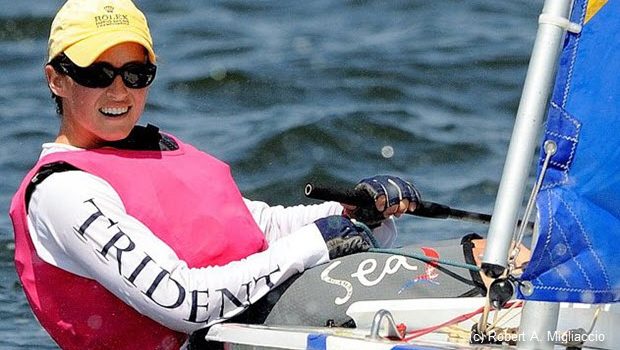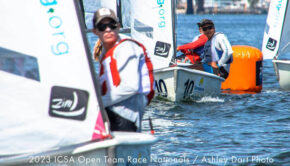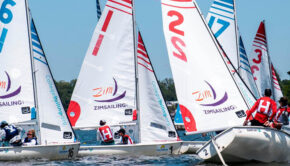Beyond the Boats of College Sailing
Published on October 1st, 2018
The college racing season has started again, with students and coaches across the USA beginning the process of how to build and mold a cohesive, talented team.
Amanda Callahan, head coach and waterfront coordinator at Roger Williams University in Rhode Island, knows the routine well.
As a student, she started with their sailing team, the Hawks, in August 2007, and since has steadily had one of the top 10 college sailing teams in the country. In her spare time, her team Silver Panda has won just about every team race title in the world, and she races Sunfish and is an active women’s match racer.
Amanda shares insight with Sail America, the trade association for the US sailing industry.
How do you recruit new talent to Roger Williams and into your team?
Recruiting in college sailing is difficult, considering you aren’t offering scholarships like other college sports. So at the end of the day, you are selling your school, the virtues of your academic programs and the strength of your sailing program. You’re sharing the story of your alumni and the various paths that they have taken.
When recruiting, I’m looking at youth and high school sailing results, and trying to meet with sailors and their families at various college night events around the country in an effort to cast a wide net. I love it when prospective student athletes reach out to me. From there I try and track down their coaches to get a sense of what those student athletes are like.
I think recruiting is the hardest part of the job and an area [in which] I constantly try to improve.
Your team had a superb showing at this year’s college nationals, placing 6th in the coeds and 2nd in team racing. And you had 10 percent of the country’s designated All Americans and Honorable mentions. You are very successful at building a strong team. What team-building tips can you share that can also be translated to business?
Recruit folks who are passionate about what you’re doing (whether that is sailing, engineering, sales or building a start-up company). Invest time in them; teach them the skills necessary to be successful at whatever it is that you do. Spend time on leadership development. While it takes away from time on the water for us, it’s worth its weight in the long run.
People tend to keep the fire burning if they know they are being valued in some way. Their passion will help drive them personally and get your team to the next level. Don’t waste time with the people who don’t care. It took me a while to learn the value of “addition by subtraction.”
How can we increase retention of avid college sailors post-graduation?
It is so easy to show up and sail a lot in college. The logistics and funding are all taken care of in varsity programs. Graduating sailors have lost the skill set required to organize regatta travel, budgeting and scheduling and, to a degree, team building.
Boat ownership among the college and just post-college demographic is way down compared to when I graduated college (2003) and the result is that the team race and fleet race circuits we used to compete in don’t exist anymore. Because of all this, there aren’t a lot of opportunities for recent college grads to get on the water.
Yacht clubs and sailing centers that have invested in fleets of boats (keel boats and dinghies) are attracting the post-college set because those folks can get out on the water without owning a boat, and everything is organized for them.
I’ve seen classes (Lightning, J/24, Etchells, etc.) actively recruit college-age sailors through their boat grant programs. Those are excellent opportunities and a great service to the whole sailing community.










 We’ll keep your information safe.
We’ll keep your information safe.